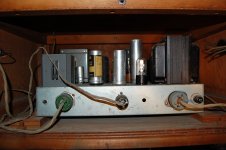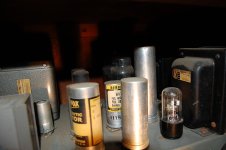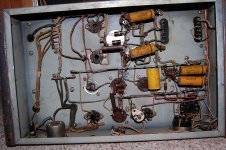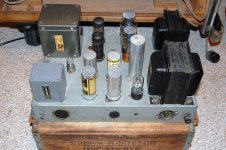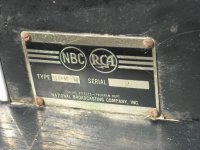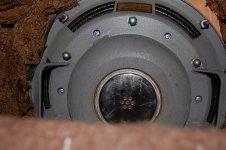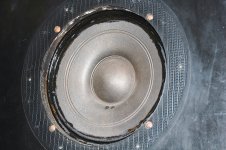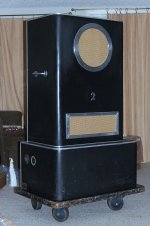I'm not sure what's going on with this amp.
It uses two 12AU7's, two 1614's, and two 5R4GY's.
One Amperite 6n045 relay.
The iron is a UTC LS-10X input , a Peerless R-800-A Power, Peerless S-265-Q output, and Peerless C-455-?. I think the last letter is an A.
My questions are:
Why the two 5R4GY's?
Why the relay?
What is the C-455-A?
Any help would be great.
Thanks!
Tom
It uses two 12AU7's, two 1614's, and two 5R4GY's.
One Amperite 6n045 relay.
The iron is a UTC LS-10X input , a Peerless R-800-A Power, Peerless S-265-Q output, and Peerless C-455-?. I think the last letter is an A.
My questions are:
Why the two 5R4GY's?
Why the relay?
What is the C-455-A?
Any help would be great.
Thanks!
Tom
Attachments
Hello, nice amp! That Peerless C-455 is a power supply choke The two rectifiers will handle more current, drop less volts, and have a lower output impedance than just one, I believe. Plus two always look cooler for sure! The relay is either for a B+ delay for the amp to avoid an over-voltage situation on the caps or for power to another accessory in what looks to be a console from the pics. Thats some nice iron and some old-nasty-dried-up electrolytics. Be wary of powering-up this one without a re-cap (speaking from experience) or you risk toasting your nice transformers. Hope that helps.
Hi Mctavish,Hello, nice amp! That Peerless C-455 is a power supply choke... Hope that helps.
Thank you!
A choke, Doh! I should have known that, but it seemed kinda big.
It's not a console, it's a Studio Monitor from WNBC television in NYC. It was built by the sound effects department.
It has a Western Electric 728B speaker.
Serial number two.
I wonder how many they made and when?
Thanks again.
Tom
Attachments
The use of Noval tubes suggests late 1940s or early 1950s vintage.
Replacing all of the electrolytic caps., as previously mentioned, is ABSOLUTELY ESSENTIAL. Replacing the waxed paper signal caps. with 716P series Orange Drops is also a good idea. Check the Carbon composition resistors for drift and noise.
The 5R4 is directly heated and turns on almost as fast as "sand". That's reason enough to use the Amperite thermal delay relay. There's plenty of room inside to add a "standard", solenoid actuated, DPDT relay, which will greatly extend the Amperite's life. Replacing a dead Amperite can be a costly experience. The amp's designer did not have that concern.
I agree, it's a KEEPER. Constructed with reliability, durability, and maintainability fore front. If only America could do things like that now.
Replacing all of the electrolytic caps., as previously mentioned, is ABSOLUTELY ESSENTIAL. Replacing the waxed paper signal caps. with 716P series Orange Drops is also a good idea. Check the Carbon composition resistors for drift and noise.
The 5R4 is directly heated and turns on almost as fast as "sand". That's reason enough to use the Amperite thermal delay relay. There's plenty of room inside to add a "standard", solenoid actuated, DPDT relay, which will greatly extend the Amperite's life. Replacing a dead Amperite can be a costly experience. The amp's designer did not have that concern.
I agree, it's a KEEPER. Constructed with reliability, durability, and maintainability fore front. If only America could do things like that now.

Neat!
What's the rest of it look like?
se
Thanks All!
Here is a video of it as found. Not my video.
It's from the guy I bought it from.
YouTube - 1940's RCA / NBC custom made Speaker System. One of two.
That's also an interesting looking loudspeaker! It's the first speaker that I've ever seen that has a pair of (what appears to be) lifting handles built into the frame. I wonder who the manufacturer was. It looks similar to certain Altecs of the time period.
Thanks for sharing this!
Thanks for sharing this!
That's also an interesting looking loudspeaker! It's the first speaker that I've ever seen that has a pair of (what appears to be) lifting handles built into the frame. I wonder who the manufacturer was. It looks similar to certain Altecs of the time period.
Thanks for sharing this!
The giant casters and the base are integral to the design as well.
Ease of movement must have been paramount in the design as it weighs about 250 pounds and is 61" h x 35" w x 25" d.
It is very well built.
Attachments
- Status
- This old topic is closed. If you want to reopen this topic, contact a moderator using the "Report Post" button.
- Home
- Amplifiers
- Tubes / Valves
- Would someone explain this amp to me please?
